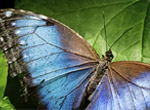Most animals can’t produce blue pigment, yet it’s common among butterflies and birds. We uncover the science behind this phenomenon.
By Amanda Lecky
If you were to take a poll around the world asking people to name their favorite color, chances are good that across every culture the most common answer would be “blue.” Studies have shown that about half of us favor blue over all other colors — about twice as often as the next most preferred color, green. Why all the blue love? Color experts have some theories.
“It differs culturally, of course, but in American society blue — particularly navy blue — is a color we trust: Our police officers, businessmen and military personnel often wear blue,” says Jackie Jordan, director of Color Marketing at Sherwin-Williams. “More broadly, blue is the color of the sky and the sea, and many of us associate the color with a sense of peace and serenity — and maybe even beach vacations.”

|

|

|
Although blue is common in the natural world, the majority of animals can’t actually produce blue pigment. So how do butterflies, beetles, monkeys and birds get their vibrant blue hues? Unlike most brightly hued creatures, who get pigment from their diet — flamingos, for example, are born gray and obtain their pink from the carotenoids in their food — blue animals rely on optical technology to create the appearance of the color on their bodies.

“Blue morpho butterflies are a good example,” says biologist Dan Babbitt, manager of the Smithsonian Natural History Museum’s Insect Zoo and Butterfly Pavilion. “Their wings are covered with scales attached to a clear membrane. Under magnification, you can see tiny divots or slits in those scales. When light shines into the divots and is reflected back out, it creates the effect of the vivid blue we associate with the blue morpho. But the color is created structurally, not from pigment.”
Understanding how animals can appear blue is one thing; getting to the why is more difficult, even for scientists. “It’s really all hypothesis at this point,” Babbitt says. “One explanation is that blue is just so different. In the green rainforest, blue really stands out. So it may be attractive in its uniqueness.”
Evolutionary biologist Richard Prum of Yale University says blue’s standout beauty may be used as a mating tactic, pointing to the satin bowerbird of Australia for example. “The males build an architectural bower to attract the females, and then they fill it with bright blue items they’ve collected, anything from flowers to pieces of trash. The more blue, the more attractive that bower — and that male — becomes,” Prum says.
Ultimately, “what’s beautiful in nature is a popularity contest,” he says. “And things evolve a certain way because they’re popular.”
Design is no different. In our beach-vacation-loving, denim-wearing culture, it’s hard to miss with blue. “Whether you pick a trendy indigo or stick with classic navy, you have almost endless options,” Jordan says. “One of them is sure to resonate with your client.”
Explore the blues
You can explore Sherwin-Williams blues on our Paint Colors by Family page.










